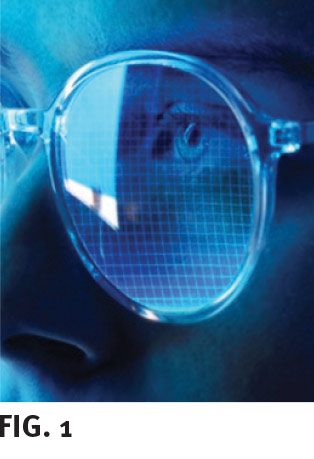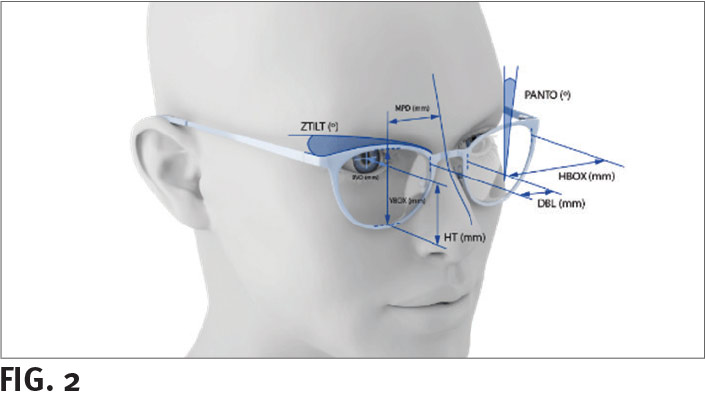Sponsored by IOT
By Deborah Kotob
Digital free-form lenses have existed since 2000, yet the terms used to define concepts related to these highly technical lenses still confuse us. For example, opticians use the terms personalization and compensation interchangeably, but they are different yet often related concepts.

Because many free-form processes are interdependent, understanding each process and how it relates to others should prove helpful to the ECP. Below we provide a basic glossary of common terms used to describe digital free-form processes and concepts.
Digital free-form technology is the state-of-the-art lens technology used for calculating, designing and cutting (surfacing) customized ophthalmic lenses.
Digital free-form lens design software (LDS) uses powerful algorithms to calculate and map the optimal design surface topography point by point across the lens for each job. The LDS generates a data points file sent to the laboratory’s computer numerical control (CNC) generator.
Laboratory Management Software (LMS) directs all optical laboratory order processing, manufacturing and shipping. It receives the orders and stores all critical information. From start to finish, the LMS controls every prescription lens job, including transmitting the job specifications to the LDS for surface calculations and transferring the LDS data points file to the CNC generator for surfacing.
CNC generators receive the LDS-generated data points file from the LMS. It uses this information to control the tools that produce the back surface of the lens, point by point, with incredible precision. First, these generators digitally control the roughing tool that cribs the lens. Then the diamond tip lathe produces the surface topography, followed by a rotating multi-axis polishing tool that refines the surface to within 1/100th of a diopter.
Semi-finished lens blanks have a finished front and unfinished back surface. The semi-finished lens blank has a front (base) curve but is not a finished lens until a CNC generator has machined the back surface curves. The original free-form patent was for direct to surface application of the Rx and the PAL design to the back surface of a semi-finished single vision lens (still used today). But today, free-form design and surfacing expanded into digitally optimized single vision lens design and dual surface PAL application. And there is a specialty free-form PAL lens designs that doesn’t start with a SFSV lens blank but instead has a unique, continuously steepening front surface curvature known as the Camber lens blank.
Refractive (as prescribed) lens power is the refracted lens power prescribed by the doctor. This power results from light traveling through a flat lens perpendicular to the patient’s visual axis. It does not reflect the effective power a wearer perceives once a pair of lenses is mounted in a frame and worn.
Compensated (as worn) lens power changes the effective power in a tilted lens so that the wearer perceives the prescribed power. Compensated verification values tell us what the compensated power in a tilted lens will read when verified in a lensometer with the lens flat.
Optimization is when the free-form LDS calculates the optimal lens surface to produce optimal optics and minimize off-axis aberrations such as oblique astigmatism and mean power error.
Personalized aka individualized aka customized lenses are individualized with “curvatures that are specific for the prescription, the frame as fitted and the patient’s anatomy,” (Palmer Cook, OD).

Personalization parameters are LDS optimal lens surface calculations that incorporate individual Rx and frame fit parameters. Frame fit parameters include prescription, addition, monocular pupillary distance (MPD), wrap angle (ZTILT), back vertex distance (BVD), pantoscopic tilt (PANTO), pupil height (HT), frame dimensions (VBOX/HBOX/DBL) and near working distance.
Position of wear (POW) personalization parameter measurements provides the LDS with frame fit data used to determine the position of the lens optical axis relative to the patient’s visual axis when the frame is worn. These measurements are used in the LDS lens surface calculations to compensate the lens for the power/astigmatic errors induced by lens tilt and off-axis gaze directions. When POW values aren’t provided by the ECP, default values are used with tremendous success. Not only that, but default POW free-form lenses are superior to other free-form lenses with no compensation.
Oblique aberrations are lens optical power errors in non-central areas of the lens or areas with oblique angles. The main optical aberrations in ophthalmic optics are oblique power error (mean power error) and oblique astigmatism error (cylinder error).
Ray trace is the computerized simulation and modeling of an optical system’s geometric components. Ray Trace simulation and light behavior modeling of lens optical systems are vital data used in the design of ophthalmic lenses.












